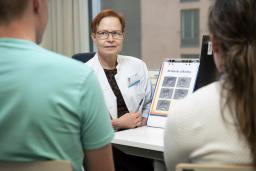Statistics on infertility treatment
In recent years, the number of patients treated for infertility has increased at HUS. The probability of the success of infertility treatments is individual. It depends on age, lifestyle and the cause of infertility, among others.

In the HUS area, fertility treatments are centralized in the Reproductive Medicine Unit. Infertility is the largest single diagnosis group of those treated at the Reproductive Medicine Unit. In the unit, we also treat other diseases related to hormonal function.
In recent years, the numbers of patients treated for infertility and the provided infertility treatments have increased.
| YEAR | QTY |
|---|---|
| 2020 | 3617 |
| 2021 | 3954 |
| 2022 | 4132 |
| 2023 | 4456 |
Learn more about the procedures on the “Treatment of infertility” page.
The table indicates the number of different procedures conducted in 2017–2023.
| PROCEDURE | 2017 | 2018 | 2019 | 2020 | 2021 | 2022 | 2023 |
|---|---|---|---|---|---|---|---|
| Egg harvesting | 837 | 1019 | 856 | 821 | 1125 | 1021 | 1071 |
| Preimplantation genetic testing | 34 | 52 | 67 | 65 | 86 | 86 | 128 |
| Embryo transfer | 1472 | 1669 | 1480 | 1403 | 1885 | 1715 | 1996 |
| Insemination | 815 | 833 | 799 | 991 | 1129 | 1069 | 1076 |
Results of infertility treatments
The results of infertility treatments are affected by factors such as the patient’s age and lifestyle, e.g. smoking or being underweight or overweight. Treatment results are also affected by the duration of attempting to get pregnant and the underlying cause of infertility.
The table indicates the number of live births after infertility treatment in 2019–2022.
| YEAR | NUMBER OF CHILDREN |
|---|---|
| 2019 | 486 |
| 2020 | 475 |
| 2021 | 625 |
| 2022 | 564 |
The table indicates the average ages at the start of the first in vitro fertilization treatment in 2018–2022.
YEAR | WOMAN’S AGE | MAN’S AGE |
2018 | 33.2 | 35.8 |
2019 | 33.4 | 36.5 |
2020 | 34.2 | 35.0 |
2021 | 34.3 | 36.6 |
2022 | 34.3 | 36.3 |